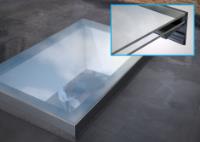 Add My Company
Add My Company
Sign In

Any building project that involves significant change of use or appearance of a building requires careful consideration as to whether planning permission is needed. There are many types of rooflight available on the market today and your selected product will determine whether or not planning permission is required.
For example an access product, such as a sliding box rooflight, is far more likely to need input from your local planning authority than a low profile fixed rooflight.
Having said that, there are instances where Planning Permission may not be a necessity in order to undertake building works.
Permitted Development
Provided your plans do not involve extending the overall footprint of the building, permitted development rules in England and Wales allow the installation of roof lights or skylights subject to the following limits and conditions:
• Any new flat roof skylights cannot project more than 150 millimetres from the existing roof plane.
• No alteration must be higher than the existing roof.
• Side-facing windows must be obscure glazed with any opening to be made 1.7 metres above the floor.
Although installation of roof lights may be covered under permitted development, in most cases even the most low profile rooflight will require an upstand to securely fix to. This is particularly evident with flat roof applications, as many waterproof membrane companies will insist that an upstand of 150mm minimum is constructed in order to maintain their guarantee.
When you take into account that the upstand is commonly installed on a pitch to allow water to drain off the roof light, further increasing the upstand height, it is likely that planning permission will be required as the rooflight will project more than the allowed 150mm from the existing roof plane.
In any case it is advisable that you seek advice from your local planning authority before commencing work on site to ensure that the proper permissions are in place.
You can read more information on this here.
Building Regulations
Regardless of the above, you will need to follow Building Regulations guidance for some aspects of your project such as structural elements and electrical works.
This is because installing a rooflight requires the existing roof structure to be altered; factors such as loading, insulation, ventilation and fire performance in relation to the proximity of a boundary can all play a fundamental role in the installation process.
Installing your glass rooflight should never affect the performance of your roof, which is why such regulatory laws are in place in order to ensure you have complied to the appropriate safety standards and to assess the overall energy performance of your product.
To read more on building regulations that apply to glass rooflights click here.
Listed building and conservation areas
If you own a listed building or plan to install a skylight within a designated conservation area, then planning permissions for your product may be subject to change.
Therefore, always check with your local authority as well as ‘Article 4 Direction’ for information on whether installation is permitted.
Please bear in mind that planning permissions for glass rooflights in Scotland and Ireland do vary in comparison to England and Wales, so once again check with your local authority in order to identify whether further approval is needed before continuing with your project.
Browse the Rooflights.com product range at the online rooflight shop.
For more information on Do I need planning permission to install a flat roof glass skylight? talk to rooflights.com
Enquire Now
More Case Studies & Blogs
List your company on FindTheNeedle.

